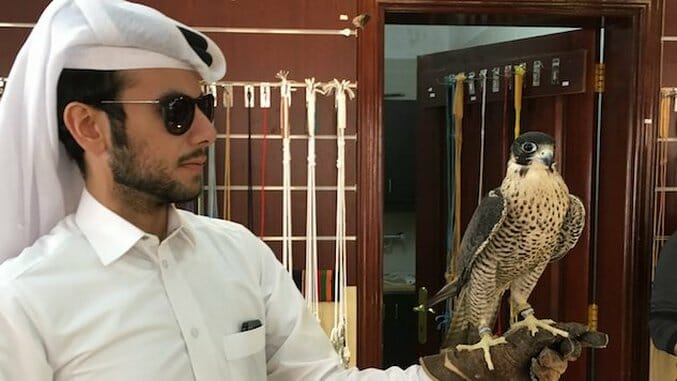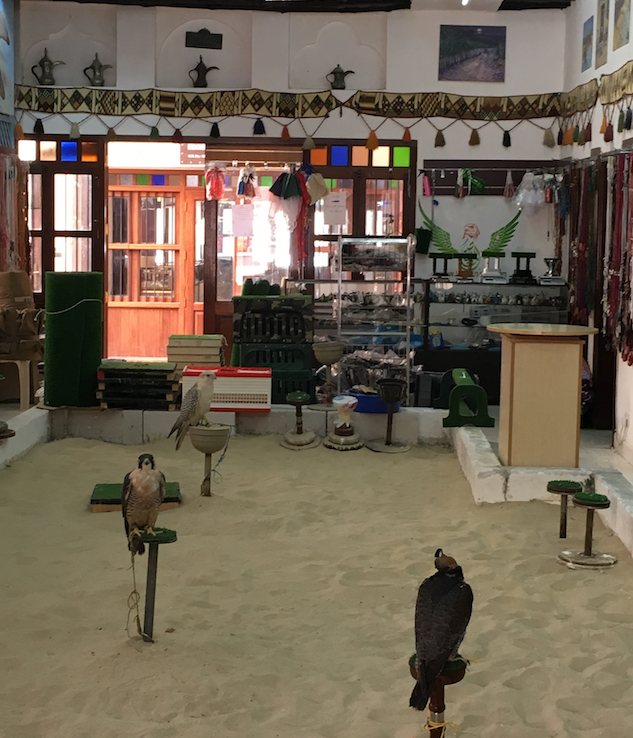
On a blindingly sunny day in February at the Falcon Souq in Doha, a man in a bright white thoub and sleek sunglasses holds a falcon on his gloved left arm. The hooded raptor flaps around in his potential new master’s grip, but the man’s deft control keeps it steady. The man inspects the falcon thoroughly, stretching out the wings, minutely studying its feathers. He nods at the shop owner, and the deal is done. The man pays 30,000 Qatari Riyal, or about $8,240 USD, for the bird.
“Don’t look so shocked,” the shop owner says with a laugh as he takes in my look of surprise at the sum. “That’s a small amount. They go for much more than that.”
When asked why he’s purchasing the bird, the buyer says with a shrug, “I just like them.” This is his fourth falcon. This isn’t surprising in Qatar, where collecting falcons is considered a national pastime and a status symbol. Although it is now the richest country in the world with a surplus of skyscrapers and $1 million sports cars, Qatar started off as a barren desert where Bedouins relied upon falcons for hunting prey. (Falcons are some of the fastest birds in the world; the Peregrine Falcon is believed to be the fastest animal on earth, reaching speeds of up to 240MPH during a dive). Today, Qataris continue falconry in an effort to preserve their culture. UNESCO even added falconry to its list of Intangible Cultural Heritage of Humanity List for Middle Eastern culture.

Photo courtesy of Visit Qatar
The sport of falconry, “the art of training hawks to hunt in cooperation with a person,” is generally believed to have originated in Persia and the Mongolian steppes around 4000 B.C. It existed in the Middle East for several millennia, and is even referred to in the Epic of Gilgamesh, a poem from ancient Mesopotamia. The Babylonians are said to have created a council on falconry. It was the sport of kings, who often gifted each other prized birds. Al Harith bin Mu’awiya, of present-day Saudi Arabia, was one of the first monarchs to train and hunt with falcons, elevating it to a royal status. Arab poets wrote peons to the art. Even the Quran deemed prey caught by falcons to be halal, a boon for the majority-Muslim countries that practice the sport. But falconry used strictly for hunting took a back seat in the 15th century with the invention of gunpowder. As a sport, however, it continues to this day.
“Qatar wants to promote falconry internationally because it’s something unique to this area,” says my tour guide, Shyam. “It’s one of the top countries in this region that is investing in falconry for both tourism and heritage.”
The government’s investment includes the Falcon Souq, a section of Souq Waqif dedicated to the sale of raptors. The aforementioned transaction takes place here at the rather unimaginatively named Birds Center, Falcon Sale & Accessories, one of 30 or so shops at the Falcon Souq. Hooded falcons are tied to wooden stands within a long rectangular enclave, a tableau seen throughout the market. The birds are kept hooded because they imprint as their master whomever they see first (the word “hoodwinked” originates from the sport). In each of the airy shops, accessories from leather ties to gloves to hoods line the walls and populate glass shelves. Plush benches invite potential buyers to sit and get to know their potential purchase. One of the shopkeepers tells me that during high season, which lasts from October through March, each shop can sell up to 100 falcons. He says the most popular breed tends to be the Shaheen, which has a slim body and wider hips and flies “like an arrow.”
Although Souq Waqif dates back to the 18th century, the Falcon Souq has been around for just a few decades. It was built in an effort to help keep falconry alive. While the souq’s mazelike, whitewashed lanes styled in arabesque architecture are piled high with spices and clothing and incense and gold, falcons are some of the most expensive items for sale. Each month, the Falcon Souq hosts an auction (only men are allowed to attend) where birds can fetch millions of Riyals. Falcons are judged on their species, speed and looks, among other characteristics. There are breeding centers in Qatar, but most falcons are brought in from countries like Pakistan, Afghanistan and Syria, among others.

Photo by Sarah Khan
With that sort of investment in the sport, owners expect top-notch health care for their birds. (But they never call it a pet. As Shyam explains: “The falcon saved the Bedouins from starving. It was an essential for hunting and the Qataris still revere it today as a sign of respect.” A recent viral photo of falcons in an airplane cabin with human passengers attests to with how much care Arabs treat the birds. Falcons are even issued their own passports. Between 2002 and 2013, the UAE issued more than 28,000 falcon passports). Part of the souq’s infrastructure includes a state-of-the-art government-funded falcon hospital, which treats up to 100 birds a day. I meet Prasoon Ibrahim, a molecular biologist at the three-story space. He leads me on a tour of the premises. The doctors here perform surgery—the most common operation is fixing the birds’ shoulder. When a falcon goes in for the kill, it can reach speeds of up to 240 miles per hour. If it misses the prey, there is a chance it will hit the ground and break or fracture its shoulder. Because the bones are hollow, fractures are harder to fix than clean breaks. For falcons with muscle damage, there is even physiotherapy.
Falcon owners can also request lab tests as well DNA pathogen detection and gene sequencing. When the birds are unable to regenerate feathers due to an injury, the hospital can replace the feathers with a technique called imping where feathers are glued back in place. A bank at the imping station holds feathers for every type of species and body part and in every color imaginable to make sure the plume looks natural.

Photo by Sahar Khan
All treatments at the hospital are free except for a nominal charge for extra tests. “This is a government-run hospital in order to help support their culture,” Ibrahim says. “It’s to encourage the falconers to raise more falcons.” He says one of the goals of the hospital staff is to educate the owners and falconers so they can detect problems before they become serious. Most falconers bring their birds by every two to three weeks or after a trip to the desert. “Now they speak like technicians,” Ibrahim says with a laugh.
Back in the market, shopkeepers are locking up for afternoon prayers and an escape from the midday heat; the market will open again in the evening. I wander into the sole shop that’s still open. A shopkeeper, Faizan Rahi, gazes placidly at the handful of birds. He points to a falcon—a golden brown beauty with a pale yellow beak—that’s worth 50,000 Rials, or about $14,000. “We once sold one for 170,000 Rials [about $47,000],” he says.
A mother and daughter walk into the store and ask to hold a falcon. Rahi politely says no. “They can bite,” he says. He tells me that the shop sees curious tourists from all over the world come to the shop, asking to hold the birds. But only the Qataris purchase them. I ask if he likes falcons. Rahi laughs heartily. “No,” he says. “For me it’s just a job. But for the Qataris, these birds are a passion.”